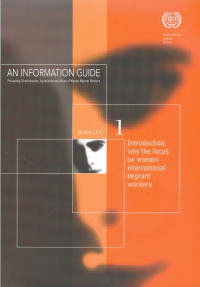
Text
Booklet 1 introduction: why the focus on women international migrant workers
The Guide shows that changing labour markets with globalization have increased both opportunities and pressures for women to migrate. Women are migrating for employment on almost the same scale as men, accounting for about half of the total migrants worldwide. For many women, as for men, migration is a positive experience, leading to a better life and improvement of their economic and social position. The labour migration process can enhance their earning opportunities, autonomy and empowerment and, thereby, change gender roles and responsibilities and contribute to gender equality. Women migrants are able to achieve their goals and may gain comparatively more than male migrants, not so much in terms of income, but in status and position back home. Although they may earn less than male migrants and they usually work in non-regulated sectors of the labour market, they are often able to improve the economic position of their family and their own status, independence and decision-making power within the family. They may also be able to have a better chance in the local labour market upon return and to earn money to start their own business. But migration for employment can also expose women to serious violation of their human rights, including their labour rights. Whether in the recruitment stage, the journey across national borders, transit or living and working in another country, women migrant workers, especially those in irregular situations, are vulnerable. They are exposed to harassment, intimidation or threats to themselves and their families, economic and sexual exploitation, racial discrimination and xenophobia, poor working conditions, increased health risks and other forms of abuse, including trafficking into forced labour, debt bondage, involuntary servitude and situations of captivity. The concern is that the overall feminization of international migration is likely to continue and that the vulnerability of women migrants to discrimination, exploitation and abuse is also likely to increase – because of hardened attitudes towards migrants in general 1 and because gender-based attitudes and perceptions continue to be slow in changing. Gender inequalities persist and labour markets remain highly segmented and segregated in both origin and destination countries.
Availability
| KP X.000129 | KP X.IND i | My Library | Available |
Detail Information
- Series Title
-
An information guide preventing discrimination, exploitation and abuse of women migrant workers
- Call Number
-
KP XI LIM i
- Publisher
- Jenewa : International Labour Organization (ILO)., 2006
- Collation
-
80p. ; 30cm.
- Language
-
English
- ISBN/ISSN
-
9221137635
- Classification
-
KP X
- Content Type
-
-
- Media Type
-
-
- Carrier Type
-
-
- Edition
-
-
- Subject(s)
- Specific Detail Info
-
-
- Statement of Responsibility
-
-
Other version/related
No other version available
File Attachment
Comments
You must be logged in to post a comment
 Computer Science, Information & General Works
Computer Science, Information & General Works  Philosophy & Psychology
Philosophy & Psychology  Religion
Religion  Social Sciences
Social Sciences  Language
Language  Pure Science
Pure Science  Applied Sciences
Applied Sciences  Art & Recreation
Art & Recreation  Literature
Literature  History & Geography
History & Geography